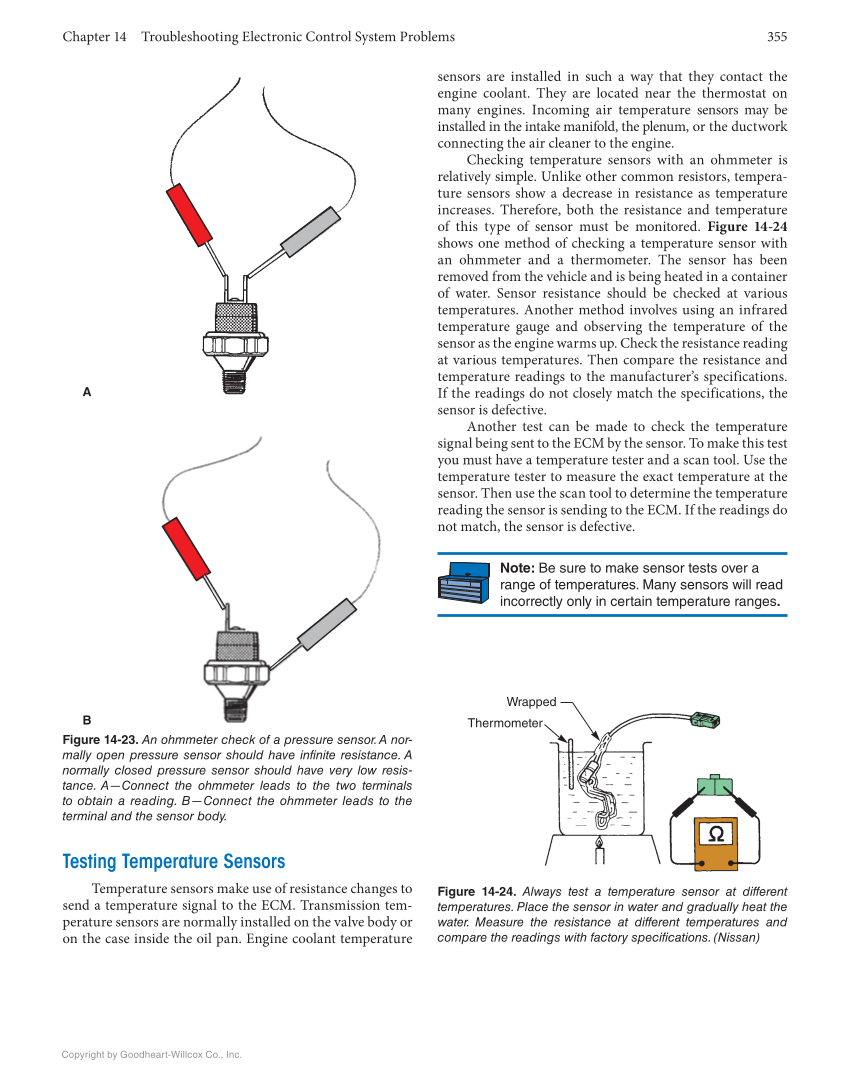Chapter 14 Troubleshooting Electronic Control System Problems 355 Copyright by Goodheart-Willcox Co., Inc. sensors are installed in such a way that they contact the engine coolant. They are located near the thermostat on many engines. Incoming air temperature sensors may be installed in the intake manifold, the plenum, or the ductwork connecting the air cleaner to the engine. Checking temperature sensors with an ohmmeter is relatively simple. Unlike other common resistors, tempera- ture sensors show a decrease in resistance as temperature increases. Therefore, both the resistance and temperature of this type of sensor must be monitored. Figure 14-24 shows one method of checking a temperature sensor with an ohmmeter and a thermometer. The sensor has been removed from the vehicle and is being heated in a container of water. Sensor resistance should be checked at various temperatures. Another method involves using an infrared temperature gauge and observing the temperature of the sensor as the engine warms up. Check the resistance reading at various temperatures. Then compare the resistance and temperature readings to the manufacturer’s specifications. If the readings do not closely match the specifications, the sensor is defective. Another test can be made to check the temperature signal being sent to the ECM by the sensor. To make this test you must have a temperature tester and a scan tool. Use the temperature tester to measure the exact temperature at the sensor. Then use the scan tool to determine the temperature reading the sensor is sending to the ECM. If the readings do not match, the sensor is defective. Note: Be sure to make sensor tests over a range of temperatures. Many sensors will read incorrectly only in certain temperature ranges. Testing Temperature Sensors Temperature sensors make use of resistance changes to send a temperature signal to the ECM. Transmission tem- perature sensors are normally installed on the valve body or on the case inside the oil pan. Engine coolant temperature Figure 14-23. An ohmmeter check of a pressure sensor. A nor- mally open pressure sensor should have infinite resistance. A normally closed pressure sensor should have very low resis- tance. A—Connect the ohmmeter leads to the two terminals to obtain a reading. B—Connect the ohmmeter leads to the terminal and the sensor body. A B Figure 14-24. Always test a temperature sensor at different temperatures. Place the sensor in water and gradually heat the water. Measure the resistance at different temperatures and compare the readings with factory specifications. (Nissan) Wrapped Thermometer
